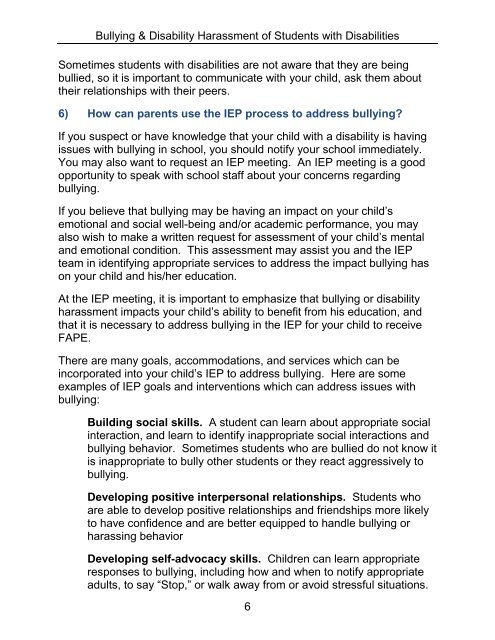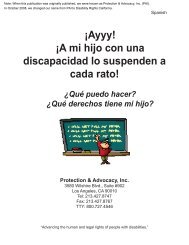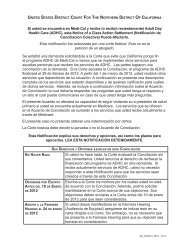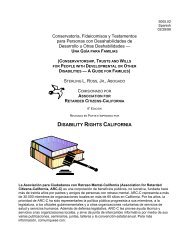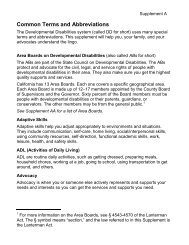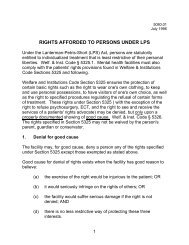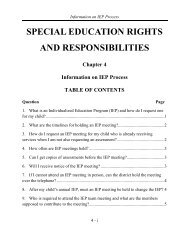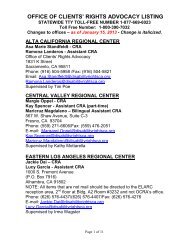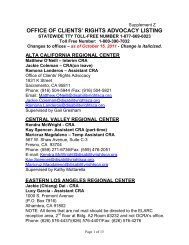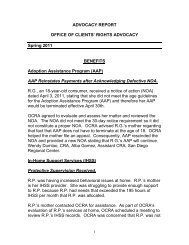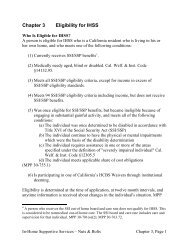Bullying & Disability Harassment of Students with Disabilities
Bullying & Disability Harassment of Students with Disabilities
Bullying & Disability Harassment of Students with Disabilities
Create successful ePaper yourself
Turn your PDF publications into a flip-book with our unique Google optimized e-Paper software.
<strong>Bullying</strong> & <strong>Disability</strong> <strong>Harassment</strong> <strong>of</strong> <strong>Students</strong> <strong>with</strong> <strong>Disabilities</strong><br />
Sometimes students <strong>with</strong> disabilities are not aware that they are being<br />
bullied, so it is important to communicate <strong>with</strong> your child, ask them about<br />
their relationships <strong>with</strong> their peers.<br />
6) How can parents use the IEP process to address bullying?<br />
If you suspect or have knowledge that your child <strong>with</strong> a disability is having<br />
issues <strong>with</strong> bullying in school, you should notify your school immediately.<br />
You may also want to request an IEP meeting. An IEP meeting is a good<br />
opportunity to speak <strong>with</strong> school staff about your concerns regarding<br />
bullying.<br />
If you believe that bullying may be having an impact on your child’s<br />
emotional and social well-being and/or academic performance, you may<br />
also wish to make a written request for assessment <strong>of</strong> your child’s mental<br />
and emotional condition. This assessment may assist you and the IEP<br />
team in identifying appropriate services to address the impact bullying has<br />
on your child and his/her education.<br />
At the IEP meeting, it is important to emphasize that bullying or disability<br />
harassment impacts your child’s ability to benefit from his education, and<br />
that it is necessary to address bullying in the IEP for your child to receive<br />
FAPE.<br />
There are many goals, accommodations, and services which can be<br />
incorporated into your child’s IEP to address bullying. Here are some<br />
examples <strong>of</strong> IEP goals and interventions which can address issues <strong>with</strong><br />
bullying:<br />
Building social skills. A student can learn about appropriate social<br />
interaction, and learn to identify inappropriate social interactions and<br />
bullying behavior. Sometimes students who are bullied do not know it<br />
is inappropriate to bully other students or they react aggressively to<br />
bullying.<br />
Developing positive interpersonal relationships. <strong>Students</strong> who<br />
are able to develop positive relationships and friendships more likely<br />
to have confidence and are better equipped to handle bullying or<br />
harassing behavior<br />
Developing self-advocacy skills. Children can learn appropriate<br />
responses to bullying, including how and when to notify appropriate<br />
adults, to say “Stop,” or walk away from or avoid stressful situations.<br />
6


